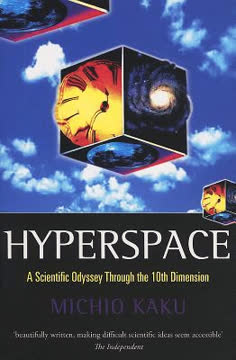Key Takeaways
1. The convergence of quantum, computer, and DNA revolutions will reshape the 21st century
"The three great themes in science in the twentieth century—the atom, the computer, and the gene."
Technological synergy. The 21st century will be defined by the convergence and cross-pollination of three fundamental scientific revolutions:
- Quantum revolution: Understanding matter at the atomic and subatomic level
- Computer revolution: Exponential growth in computing power and artificial intelligence
- DNA revolution: Decoding the human genome and manipulating genetic information
This convergence will lead to unprecedented advances in:
- Nanotechnology
- Quantum computing
- Personalized medicine
- Gene therapy
- Artificial intelligence
- Biotechnology
The interplay between these fields will accelerate scientific progress and create entirely new industries, potentially solving some of humanity's greatest challenges in health, energy, and the environment.
2. Moore's Law will drive technological progress until 2020, then new paradigms will emerge
"By 2020, the reign of silicon will end and entirely new computer architectures will have been created."
Beyond silicon. Moore's Law, which predicts the doubling of computing power every 18 months, has been the driving force behind technological progress for decades. However, this exponential growth faces physical limitations:
- By 2020, silicon-based transistors will approach the atomic scale
- Quantum effects will interfere with traditional circuit design
- Heat dissipation becomes a major challenge at the nanoscale
To overcome these limitations, researchers are exploring alternative computing paradigms:
- Quantum computers: Harnessing quantum superposition for exponential processing power
- Optical computers: Using light instead of electricity for faster data transmission
- DNA computers: Leveraging biological molecules for massive parallel processing
- Neuromorphic computing: Mimicking the structure and function of the human brain
These new paradigms may sustain exponential growth in computing power beyond 2020, enabling previously unimaginable technological feats.
3. Ubiquitous computing will make technology invisible and integrated into our environment
"Machines that fit the human environment instead of forcing humans to enter theirs will make using a computer as refreshing as taking a walk in the woods."
Invisible integration. The future of computing lies in its disappearance from our conscious awareness. Ubiquitous computing, or "ubicomp," envisions a world where:
- Microchips are embedded in everyday objects and environments
- Technology responds to our presence and anticipates our needs
- Interfaces become natural and intuitive, based on speech, gestures, and context
Examples of ubicomp technologies:
- Smart homes that adjust lighting, temperature, and security automatically
- Wearable devices that monitor health and provide real-time information
- Augmented reality interfaces that overlay digital information on the physical world
- Internet of Things (IoT) devices that communicate and coordinate seamlessly
This shift towards invisible, pervasive computing will fundamentally change how we interact with technology and our environment, making digital assistance an omnipresent and effortless part of daily life.
4. Artificial intelligence will evolve from narrow applications to potentially conscious machines
"Sometime in the next thirty years, very quietly one day we will cease to be the brightest things on earth."
AI evolution. The development of artificial intelligence will progress through several stages:
- Narrow AI (present - 2020): Specialized systems excelling at specific tasks
- General AI (2020 - 2050): Machines with human-like reasoning and problem-solving abilities
- Superintelligent AI (beyond 2050): Systems surpassing human intelligence across all domains
Key milestones in AI development:
- Natural language processing and understanding
- Common sense reasoning and knowledge representation
- Machine learning and adaptive problem-solving
- Emotional intelligence and social interaction
- Self-awareness and consciousness (speculative)
The potential emergence of conscious machines raises profound philosophical and ethical questions about the nature of intelligence, consciousness, and our place in the universe. While the timeline for achieving true artificial consciousness remains uncertain, the rapid progress in AI capabilities will continue to transform industries and society in the coming decades.
5. The human genome project will enable personalized medicine and gene therapy
"By 2010, when you reach your eighteenth birthday, you will be able to have your own report card printed out of your individual risks for future disease based on the genes you have inherited."
Genetic revolution. The completion of the Human Genome Project by 2005 will usher in a new era of personalized medicine:
- Individual DNA sequencing becomes affordable and widespread
- Genetic predispositions to diseases can be identified early
- Targeted therapies based on genetic profiles become possible
Advances in gene therapy:
- Correcting genetic defects to cure hereditary diseases
- Enhancing the body's natural defenses against cancer and other illnesses
- Potentially slowing or reversing the aging process
Challenges and considerations:
- Ethical concerns about genetic privacy and discrimination
- Equitable access to genetic technologies and treatments
- Balancing genetic interventions with environmental factors in health
The ability to read and manipulate our genetic code will fundamentally change our approach to healthcare, shifting from reactive treatment to proactive prevention and personalized interventions.
6. Molecular medicine will revolutionize disease treatment and potentially extend human lifespan
"We are entering an era when disease will be predicted before it occurs."
Microscopic precision. Molecular medicine focuses on understanding and treating diseases at the molecular level, offering unprecedented precision and effectiveness:
- Targeted drug therapies that attack specific molecular pathways
- Nanotechnology-based treatments that operate at the cellular level
- Gene editing techniques to correct genetic defects
Potential breakthroughs:
- Curing cancer by targeting specific genetic mutations
- Reversing neurodegenerative diseases like Alzheimer's
- Regenerating damaged organs using stem cell therapies
The quest for longevity:
- Identifying and manipulating "aging genes"
- Developing treatments to slow or reverse cellular aging
- Exploring the potential for radical life extension
While the goal of dramatically extending the human lifespan remains controversial, molecular medicine promises to significantly improve quality of life and health span for many people in the coming decades.
7. Genetic engineering of plants and animals will transform agriculture and create new species
"We can put just about any molecule that has therapeutic value into plants."
Bioengineered ecosystems. Genetic engineering techniques will revolutionize agriculture and animal husbandry:
- Crops with enhanced nutritional value, disease resistance, and yield
- Animals engineered for improved meat production or medical applications
- New hybrid species combining traits from multiple organisms
Examples of genetic engineering applications:
- Drought-resistant crops to combat climate change effects
- Plants that produce pharmaceuticals or industrial chemicals
- Animals that serve as organ donors for human transplants
Potential risks and concerns:
- Unintended ecological consequences of releasing engineered organisms
- Loss of biodiversity due to dominance of engineered species
- Ethical considerations of creating and manipulating life forms
The ability to precisely engineer plants and animals will offer powerful tools to address global challenges in food security, medicine, and environmental sustainability, but will require careful regulation and ethical oversight.
8. Ethical challenges arise from the ability to manipulate the human genome and create designer babies
"We need to decide to what extent we want to design our descendants."
Genetic dilemmas. As genetic engineering technologies advance, society will face profound ethical questions:
- Should we allow genetic enhancement of human traits?
- How do we define the boundary between therapy and enhancement?
- Who should have access to genetic technologies, and how should they be regulated?
Potential scenarios:
- Parents selecting embryos with desired genetic traits
- Gene therapy to enhance cognitive or physical abilities
- Creating genetically modified "designer babies"
Ethical considerations:
- Exacerbating social inequalities through genetic advantages
- Preserving human diversity and unpredictability
- Respecting the autonomy of future generations
The ability to manipulate the human genome offers immense potential for eliminating genetic diseases and enhancing human capabilities, but also raises complex moral and philosophical questions about the nature of humanity and our role in shaping our own evolution.
9. The biomolecular revolution offers both tremendous benefits and potential dangers to society
"The very reductionism to the molecular level that is fueling the medical revolution also poses the greatest moral challenge we face."
Double-edged sword. The biomolecular revolution presents a complex landscape of opportunities and risks:
Benefits:
- Curing genetic diseases and extending healthy lifespans
- Increasing food production and nutritional value
- Developing new materials and energy sources
Potential dangers:
- Accidental release of engineered organisms into the environment
- Bioterrorism and weaponization of genetic technologies
- Exacerbation of social inequalities through genetic enhancements
Balancing progress and caution:
- Implementing robust regulatory frameworks for genetic technologies
- Fostering public dialogue and education about bioethical issues
- Promoting international cooperation to address global challenges and risks
The biomolecular revolution has the potential to solve many of humanity's most pressing problems, but it also requires careful consideration of its long-term consequences and ethical implications. Striking the right balance between innovation and responsible development will be crucial in shaping a positive future for humanity in the age of genetic engineering.
Last updated:
FAQ
What's Visions: How Science Will Revolutionize the 21st Century about?
- Exploration of Future Science: The book delves into how advancements in science, particularly in artificial intelligence, genetics, and nanotechnology, will reshape society in the 21st century.
- Three Scientific Revolutions: Michio Kaku identifies three key revolutions: the computer revolution, the biomolecular revolution, and the quantum revolution, each expected to significantly impact our understanding and manipulation of matter, life, and intelligence.
- Interdisciplinary Approach: Kaku combines physics, engineering, and biology to explore how these fields intersect and contribute to future innovations, providing a comprehensive understanding of potential advancements.
Why should I read Visions: How Science Will Revolutionize the 21st Century?
- Insightful Predictions: The book offers a well-researched look into the future of technology and its implications for humanity, based on interviews with over 150 scientists.
- Engaging Writing Style: Michio Kaku's ability to explain complex scientific concepts in an accessible manner makes the book enjoyable for both lay readers and experts.
- Broader Implications: It not only discusses technological advancements but also their societal impacts, prompting readers to think critically about the future.
What are the key takeaways of Visions: How Science Will Revolutionize the 21st Century?
- Three Pillars of Science: The book outlines the three pillars of modern science: matter, life, and intelligence, which will drive future scientific discoveries and innovations.
- Emerging Synergy: Kaku discusses the synergy between the computer, biomolecular, and quantum revolutions, expected to accelerate scientific progress and create new opportunities.
- Future Predictions: Predictions are categorized into three time frames: developments expected by 2020, from 2020 to 2050, and beyond 2050, helping readers understand when to expect various technological advancements.
What are the best quotes from Visions: How Science Will Revolutionize the 21st Century and what do they mean?
- “There are three great themes in science in the twentieth century—the atom, the computer, and the gene.”: Highlights the foundational discoveries of the last century that have shaped modern science and will continue to influence future advancements.
- “Prediction is very hard, especially when it’s about the future.”: Reflects the inherent uncertainty in forecasting scientific progress, acknowledging the challenges of making accurate predictions.
- “We are now making the transition from amateur chess players to grand masters, from observers to choreographers of Nature.”: Signifies the shift in human capability to manipulate natural processes through science, encapsulating the book's central theme of empowerment through scientific understanding.
What are the three scientific revolutions discussed in Visions: How Science Will Revolutionize the 21st Century?
- Computer Revolution: Focuses on the rapid advancements in computing technology, predicting that computers will become so integrated into our lives that they will be invisible yet omnipresent.
- Biomolecular Revolution: Pertains to advancements in genetics and molecular biology, allowing us to manipulate life at the molecular level, with potential for personalized medicine and genetic engineering.
- Quantum Revolution: Involves understanding and manipulating matter at the quantum level, with breakthroughs in quantum physics leading to new technologies that can control matter in unprecedented ways.
How does Michio Kaku define the role of scientists in shaping the future in Visions?
- Collaborative Efforts: Emphasizes that no single individual can invent the future; it requires the collective efforts of many scientists across various disciplines.
- Emerging Consensus: Highlights the importance of an emerging consensus among scientists regarding future predictions, making them more reliable than individual opinions.
- Choreographers of Nature: Describes scientists as "choreographers" who will actively shape the future through their discoveries, illustrating their proactive role in directing technological advancements.
What are the potential societal impacts of the scientific revolutions according to Visions?
- Economic Shifts: Scientific revolutions will lead to significant changes in the economy, with new industries emerging and existing ones transforming, resulting in job displacement and new opportunities.
- Ethical Considerations: Raises important ethical questions regarding genetic engineering, artificial intelligence, and the manipulation of life, encouraging readers to consider the moral implications.
- Global Cooperation: Suggests that advancements in science and technology will necessitate greater global cooperation to address complex challenges like climate change and public health.
How does Michio Kaku envision the future of artificial intelligence in Visions?
- Emerging Intelligent Systems: Predicts the development of intelligent systems capable of learning and adapting to their environments, enhancing daily lives and working alongside humans.
- Self-Aware Robots: Speculates that by 2050, robots may achieve a degree of self-awareness, raising questions about their rights and roles in society.
- Integration with Humans: Discusses the possibility of merging human intelligence with artificial systems, creating cyborgs that enhance human capabilities and redefine what it means to be human.
What role does nanotechnology play in the future according to Visions: How Science Will Revolutionize the 21st Century?
- Molecular Machines: Discusses the potential of nanotechnology to create molecular machines that could perform tasks at the atomic level, revolutionizing various industries.
- Applications in Medicine: Envisions these machines being used to target diseases, clean up the environment, and repair cellular damage, potentially leading to breakthroughs in healthcare.
- Skepticism and Challenges: Acknowledges significant technical challenges before nanotechnology can be fully realized, despite its exciting possibilities.
How does Visions address the concept of room temperature superconductors?
- Energy Efficiency: Describes room temperature superconductors as a breakthrough that could drastically reduce energy loss in power transmission, making energy systems more efficient.
- Potential Applications: Outlines applications like maglev trains and advanced medical imaging technologies that could become feasible with room temperature superconductors.
- Current Research Status: Provides an overview of ongoing research efforts and breakthroughs in superconductivity, emphasizing the challenges that remain.
What are the implications of the multiverse theory discussed in Visions?
- Parallel Universes: Introduces the concept of the multiverse, where multiple universes exist simultaneously, each with different physical laws and constants.
- Anthropic Principle: Provides a framework for understanding the Anthropic Principle, suggesting that our universe is just one of many that could support life.
- Philosophical Considerations: Raises profound philosophical questions about existence, consciousness, and the nature of reality, encouraging contemplation of living in a universe that may be just one of countless others.
How does Visions explore the future of space exploration?
- Interplanetary Missions: Outlines plans for future missions to Mars and beyond, emphasizing the importance of robotic exploration as a precursor to human colonization.
- Colonization of Other Planets: Discusses the potential for humanity to establish colonies on other planets, driven by the need for survival and exploration.
- Technological Innovations: Speculates on technologies that will enable space travel, including advanced propulsion systems and life support technologies, envisioning a future where space travel becomes routine.
Review Summary
Visions: How Science Will Revolutionize the 21st Century receives mostly positive reviews, with readers praising Kaku's ability to explain complex scientific concepts and make accurate predictions. Many find the book thought-provoking and informative, covering topics like computer science, biotechnology, and quantum physics. Some readers note that parts of the book are now outdated, but still find value in comparing Kaku's predictions to current reality. A few criticisms mention repetitiveness and occasional difficulty in understanding technical concepts.
Similar Books










Download PDF
Download EPUB
.epub digital book format is ideal for reading ebooks on phones, tablets, and e-readers.












